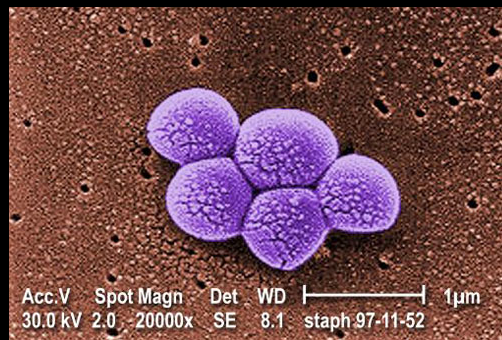What is MRSA?

This tiny cluster of bacteria is methicillin-resistant Staphylococcus aureus (MRSA), seen under a microscope. This strain of the common "staph" bacteria causes infections in different parts of the body -- including the skin, lungs, and other areas. MRSA is sometimes called a "superbug" because it is resistant to many antibiotics. Though most MRSA infections aren't serious, some can be life-threatening.
MRSA Skin Infection: Symptoms
MRSA infections can look exactly like ordinary staph infections of the skin: a small red bump, pimple, or boil. The area may be red, painful, swollen, or warm to the touch. Pus or other fluids may drain from the sore. Most MRSA skin infections are mild, but they can change, becoming deeper and more serious.
MRSA, Spider Bite or Something Else?
Bug bites, rashes, and other skin conditions can be confused with MRSA because the symptoms may be similar: red, swollen, warm, or tender. ER doctors routinely ask patients who arrive with a painful spider bite whether they actually saw the spider, because these "bites" so often turn out to be MRSA instead. When a skin infection spreads or does not improve after 2-3 days on usual antibiotics, it may be MRSA.
MRSA Skin Infection: Cellulitis
MRSA can lead to cellulitis, an infection of the deeper layers of skin and the tissues beneath. On the surface, the skin looks pink or red, like a sunburn, and may be warm, tender, and swollen. Cellulitis may spread quickly over a few hours.
MRSA Skin Infection: Abscess
MRSA can sometimes cause a deeper infection called an abscess, which is a collection of pus that can be underneath the skin. A minor skin infection that goes without proper, timely treatment can develop into an abscess. This type of infection may require surgical drainage and antibiotics to heal.
MRSA: How Do People Catch It?
MRSA can spread through physical contact with an infected person or something you've touched. Conditions that help to spread MRSA include: close skin-to-skin contact; cuts or scrapes in the skin; sharing personal hygiene articles such as razors and towels; and contact with contaminated items including door handles and athletic equipment. One in 100 people carry the bacteria on their bodies, but don't get sick.
Who Gets MRSA?
People who've recently had surgery or a hospital stay have an increased risk of developing MRSA. It's also seen in older people, those living in nursing homes, and people with weakened immune systems. A chronic medical condition like diabetes, cancer, or HIV increases your chances of getting this stubborn infection.
How Safe Are Hospitals?
Hospitals, where viruses and infections abound, have been singled out as a prime location for contracting MRSA. But hospitals are working to curb the problem. Preventative measures by health care staff include good hand hygiene and wearing gloves. It's paying off -- MRSA infections are down in hospital intensive care units.
Can Healthy People Get MRSA?
Yes. MRSA skin infections are showing up more frequently in healthy people, with none of the usual risks factors. This type of MRSA -- called community-associated MRSA (CA MRSA) -- has been reported among athletes, prisoners, and military recruits. Outbreaks have been seen at schools, gyms, day care centers and other places where people share close quarters.
MRSA in Dogs and Cats
It looks like MRSA has jumped from humans to household pets, where it can linger without obvious symptoms -- and possibly reinfect the pet owners. Only community-acquired strains have been found in cats and dogs so far.
MRSA on the Beach
MRSA has been found in the sand and water at beaches in Washington State. It's not yet clear whether a beach-goer could pick up an infection in that setting --or how the "superbug" moved from hospitals to the beach. A few ways to protect yourself: cover scrapes before playing in the sand, wash your hands frequently, and shower when you come out of the water.
How Is MRSA Diagnosed?
If you suspect that you have a MRSA skin infection, cover the site with a bandage. Contact your health care provider, who will swab a sample of the infected area and send to a lab to test whether it's MRSA and determine what antibiotics would be most effective.
How Is MRSA Treated?
Draining, cleaning, and covering the sore in the doctor's office may be the only treatment needed for skin infections, but physicians may also prescribe oral antibiotics. The antibiotics routinely prescribed no longer work for MRSA, including methicillin, amoxicillin, penicillin, oxacillin, and cephalosporins. So the doctor may use clindamycin, trimethoprim-sulfamethoxazole, or linezolid. Vancomycin has been effective in treating invasive MRSA, but must be administered intravenously.
MRSA Skin Infection: Home Care
If antibiotics are prescribed, it's important to finish all doses -- even if your symptoms fade. Stopping early can cause the infection to come back -- and can allow the MRSA bacteria to develop resistance against the few antibiotics that still work. Keep the sore covered until it has healed and change the bandages according to your doctor's advice.
MRSA Complications
MRSA can sometimes grow from a small, contained infection to one that involves internal organs or important systems in the body -- including the bones, joints, heart valves, lungs, and bloodstream. The vast majority of these serious infections are linked to health care exposure. Recent reports have found nearly 19,000 MRSA deaths in a single year.
How to Avoid MRSA
Frequent hand washing with soap and water -- or using an alcohol-based hand sanitizer -- are among the best ways to avoid MRSA. Wipe down surfaces you come into contact with at the gym and shower immediately after sports or any activity where there is frequent skin-to-skin contact. Don't touch other people's wounds or bandages or share personal items. During a hospital stay, remind staff members to wash their hands before they touch you.




















 留言列表
留言列表
 線上藥物查詢
線上藥物查詢 